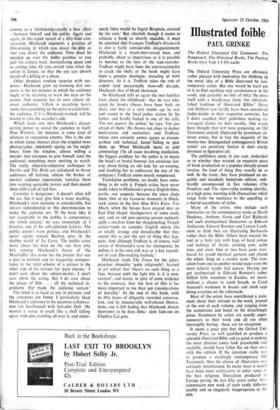The Oxford Illustrated Old Testament : The Pvitateuch, The - Historical Books,
The Poetical Books (ouP Vols 1-3 63s each)
illustrated foible
PAUL GRINKE
The Oxford University Press are obviously rather pleased with themselves for thinking up
the novel idea of a Bible illustrated by con- temporary artists. But one would be hard put to it to find anything very revolutionary in the result, and certainly no hint of what the press itself calls a breakaway from 'the old-estab- lished tradition of illustrated Bibles.' Dtirer and Holbein can hardly have been considered fuddy-duddy in their respective centuries, but I don't recollect their publishers making ex- travagant claims for their novelty. One would
have thought that OUP were proposing an Old Testament entirely illustrated by prominent ab- stract artists, but in fact the majoritY. of the twenty-two 'distinguished conteipporary, British artists' are positively fustian in their sturdy devotion to figurative art.
The publishers seem, in any case, undecided as to whether they' wanted an exquisite piece
of book production or a popular cheaply priced
version, the kind of thing they usually do so well. In the event, they have produced an un- gainly and decidedly humdrum edition, awk- wardly encompassed in five volumes (The Prophets and The Apocrypha coming shortly), at a high price, bursting with illustrations which range from the mediocre to the appalling in a horrid cacophony of styles.
Many of the artists, 'who include such luminaries on the contemporary scene as David Hockney, Anthony Gross and Ceri Richards and such distinguished illustrators as EdWard Ardizzone, Edward Bawden and Lynton Lamb, seem to think they are illustrating Barbarella
rather than the Bible. Others 'have 'treated the text as a fairy tale with hags of- focal colour
and lashings of Arabs, cooking pots, palm trees and oxen. One or two have gone over- board" for grand mystical gestures and placed the whole thing on a cosmic scale. The tran- sition from one to another would make even the most eclectic reader feel queasy. Having just got acclimatised to Edward Bawden's rather Gillish little woodcuts in Exodus, we move, without a chance to catch breath, to Carol Annand's workmen in braces and cloth caps doing overtime on the tabernacle.
Most of the artists have contributed a state- ment about their attitude to the' work, printed at the end of each volume, and ranging from the sententious and banal to the disturbingly pious. Statements by artists are usually super- numerary to their work and all. too often thoroughly boring: these are no exception. It seems a great pity that the Oxford Uni- versity Press, so well qualified to produce a splendid illustrated Bible and so good at making
the most abstruse tomes look presentable and readable, should have fallen flat on their nose with this edition. If the intention really was to produce a startlingly contemporary Old Testament, then the -choice of illustrators was curiously misinformed. In many ways it would have been more satisfactory to select some of the best religious illustration produced in Europe during the last fifty years rather than commission new work of such vastly differing quality and so singularly inappropriate to the text.














































 Previous page
Previous page